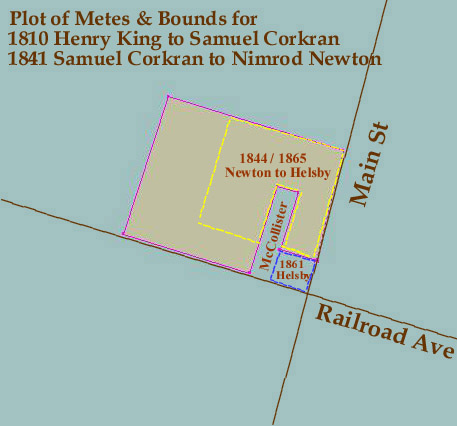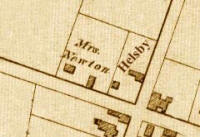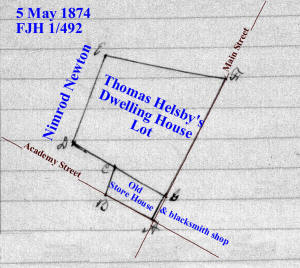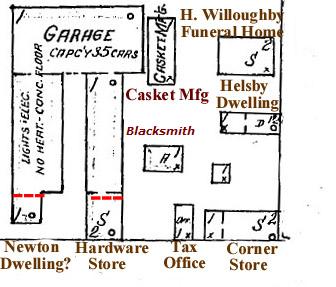East New Market
Property Reports
Northwest Corner
Properties
The various properties that comprise the northwest corner of the intersection of Main Street and Academy Street have been sold by deed and devised in probate many times over the years, but much of the property has often ended up in the same hands. Before 1802 the land was part of Anderton's Desire. In 1771 John Anderton inherited the property from his father. By 1802 the land had become the property of John Anderton Mitchell. It is presumed that a daughter or sister of John Anderton married a man name Mitchell and had a son named John Anderton Mitchell. When John Anderton Mitchell died, his lands passed to his closest heirs who were descendants of Edward King Sr. and Betty Anderton. Betty Anderton was a sister to John Anderton. Most of the land passed to Henry King, son of Edward Sr. & Betty King.
In 1810 Henry King sold the land he owned at the northwest corner to Samuel Corkran. At the time Henry King did not own two of the lots that were closer to the corner. One was a long thin rectangular lot that was described as the property of Nancy McCollister. Another was the square lot that abutted the corner of the intersection. It was owned by Mary King, daughter or Henry King's brother Edward. In 1810, Mary King's lot was the site of a granary.
In 1841, Samuel Corkran sold the exact lot he purchased in 1810 to Nimrod Newton. He did not own the rectangular lot that was then described as the lot formerly belonging to Nancy McCollister. The McCollister lot is one of East New Market's mysteries. A deed does not exist that shows McCollister or anyone else buying or selling the lot. However, when Mary Bramble sold her corner lot in 1861, she mentions the McCollister lot that she purchased from her husband's estate. Jeremiah Bramble was taxed for this lot from 1852 to 1861.
When Samuel Corkran bought this property from Henry King in 1810 he paid $75. He sold the property to Nimrod Newton in 1841 for $400. The sales price increase indicates a structure was built during this time period. In 1843 Thomas Helsby married Nimrod Newton's daughter Sarah J. Newton. A later deed indicates that Thomas Helsby was in possession of part of this property since 1844. Below is the part of Nimrod Newton's lot that he sold to Thomas Helsby.

In 1852, the tax record shows Nimrod Newton with a house and lot worth $200. The tax record also shows Helsby with a house & lot and storehouse valued at $800. The structure that was likely built by Corkran between 1810 and 1841 was either Newton's house or Helsby's house. Since I have not located a record that shows a construction date, it is currently not possible to determine which house was there first. The second house was likely built shortly after the owner acquired the property in the early 1840s. The dwelling house owned by Helsby in 1852 survived until the 1920s. It is referred to as the Helsby Dwelling. In 1852 Newton's house was nearly the lowest valued house in East New Market.
In 1860, Newton made $150 in improvements to a shop on his property. Whether the shop and house were one in the same, the assessed value of $350 continued to be one of the lowest valued properties in town. This shop was likely the Smith Tax Office or possibly the beginnings of the Saxton & Parker store. The Smith Tax Office is on the lot that was the site of Helsby's Corner Store. The office may have been moved there before the Saxton & Parker store was constructed.
 In
1861 Mary King Bramble sold her square corner lot along with the
McCollister lot to Thomas Helsby. The lot was the site of a
Blacksmith Shop in 1852. When Mary King Bramble sold the lot to
Thomas Helsby the deed did not mention a structure. Thomas Helsby
died intestate in 1865. His widow Sarah Jane Helsby was taxed for
a house and lot from 1866 to 1876. The house was the
Helsby Dwelling. When Helsby's property was divided in 1874 a storehouse and
blacksmith shop south of a division line was devised to
Causine Helsby. The 1877 map shows a square on the south side of
this line. This square may is likely the blacksmith shop. In 1876 Causine Helsby was taxed for a corner lot
and shop.
In
1861 Mary King Bramble sold her square corner lot along with the
McCollister lot to Thomas Helsby. The lot was the site of a
Blacksmith Shop in 1852. When Mary King Bramble sold the lot to
Thomas Helsby the deed did not mention a structure. Thomas Helsby
died intestate in 1865. His widow Sarah Jane Helsby was taxed for
a house and lot from 1866 to 1876. The house was the
Helsby Dwelling. When Helsby's property was divided in 1874 a storehouse and
blacksmith shop south of a division line was devised to
Causine Helsby. The 1877 map shows a square on the south side of
this line. This square may is likely the blacksmith shop. In 1876 Causine Helsby was taxed for a corner lot
and shop.
 The
land north of the division line including a dwelling house was devised to Emma Helsby,
granddaughter of Thomas Helsby. The house is known as the
Helsby Dwelling.
The
land north of the division line including a dwelling house was devised to Emma Helsby,
granddaughter of Thomas Helsby. The house is known as the
Helsby Dwelling.
When Nimrod Newton wrote his Will in 1872, he left his "his dwelling House and lot where I now live with the adjoining house and lot now occupied as a dwelling and Post office" to his wife Margaret. At her decease the land was to pass to his grandson, Causine Helsby. The Will was executed in 1876. These two structures appear on the 1877 map.
Causine Helsby died in 1881. When Margaret Newton died in 1885, the land passed to the closest heir of Causine Helsby. His only heir was his niece Emma Helsby. Emma was the daughter of Causine's brother Frelinghuysen Helsby.
After inheriting property from both of her grandfathers, Emma Helsby owned all the properties comprising the northwest corner of the main intersection. Emma was born in 1870 and a minor when she inherited this land in 1876 and 1885. Emma's mother Helen Helsby was taxed for a dwelling house at this location in 1876. From 1896 through 1910, she was taxed for a store house, a dwelling adjoining the store house, and 2 small dwellings near the storehouse. Emma Helsby married James M. Smith in 1890. The storehouse was Helsby's Corner Store which was built in 1882 and the dwelling was the Helsby Dwelling which had been there since the 1840s. Likely the Smith Tax Office was being used as a small dwelling at the time.

Emma Helsby Smith began leasing parts of her land in the late 1880s. A 1898 deed states that Emma Heslby Smith intended to record a deed for a lot she leased a lot to Edward W. Reid on 1 January 1889. The lease was for $25 a year for a term of likely 99 years. This lot fronted 40 feet on Academy Street and ran back 85 feet. It was described as beginning at the southwest corner of the lot on which the store house formerly occupied by Thomas J. Helsby, but occupied at present by W. Albert Henry stands, and west of the shop occupied by James R. Stevens. The property continued to be described this way in deeds from 1901, 1903, 1904, and 1905. Tax records from 1896 through 1910 describe the lot as the site of a Blacksmith Shop. In 1896 an old house valued at $5 was behind the blacksmith shop. It does not appear this old house survived past 1898.
Clarence Saxton began leasing the blacksmith shop lot in 1905. In 1907, he began leasing a larger property adjoining to the west. He combined both lots. He sold a half interest in his lease of both properties to William Reid in 1912, who sold the interest to Harry Parker in 1913. Saxton and Parker operated a hardware store called Saxton & Parker. The lease ended when Emma H. Smith sold the property outright to Saxton & Parker in 1919. The lot they purchased was slightly larger than the lots they leased as it included a small lot that fronted 30 feet on Academy Street and ran back from the road 65 feet. This larger lot formed a rectangle that fronted 87 feet on Academy Street and ran back 187 feet from the road. Saxton & Parker went bankrupt in the late 1920s, but Clarence Saxton was able to buy the property out of bankruptcy in 1936. He operated the store as Saxton's Hardware Store until he sold it to Albert L. Pennypacker in 1947.
When Emma H. Smith & James M. Smith filed for bankruptcy in the late 1920s, their remaining lands were sold by the bankruptcy trustee. In 1934, Clarence Saxton purchased two of the four lots at bankruptcy sale. One property was a two room office at the rear of Helsby's Corner Store. This property is known as the Smith Tax Office and had previously been referred to as being on the same lot as Helsby's Corner Store. This structure was described as the shop occupied by George W. Elliott in deeds from 1901 to 1905. And from 1898 to 1901, it was described as the shop occupied by James R. Stevens. There are many theories about when the Smith Tax Office was built and when it first occupied this location. One is that Nimrod Newton built the office in 1860 and used it as a dwelling and post office. Emma Smith who owned both properties from 1876 to 1896 may have moved to office somewhat to the east between 1877 and 1896.
[Still working on the finalizing this full account. More research is also needed.]
Some records that have not been placed yet...
1899-1901 Dorchester County Commercial Directory - East New Market
J.W. Hurst, meat market
1896-1897 Dorchester County Commercial Directory - East New Market
J.W. Hurst, meat market
1896-1910 Tax Record
Mary A. Elliott
1896 -1 house on leased land on Railroad Ave. $25
5 May 1910 - reduced by house on leased land to C.L. Saxton
Katie Hurst
1896 -
1 lot on north side of road from ENM to Secretary 32x42 feet $50
Butcher shop $50
1896 Tax
Record
Katie Hurst
1 lot situated on the north side of the county road from East New Market
to Secretary 32x42 feet $50,
Butcher Shop $50
1894-1895 Dorchester County Commercial Directory - East New Market
JW Hurst, meat mkt
1891-1892 Dorchester County Commercial Directory - East New Market
J.W. Hurst, meat market